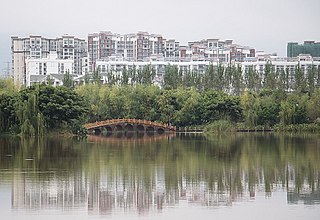Stephen G. Haw (born 1951) is a botanical taxonomist [1] and historian, specializing in subjects relating to China. He is the author of several published books and a large number of periodical articles. His most important work relates to the taxonomy of Tree Peonies [2] and to the history of the Mongol period in East Asia. He has made a major contribution to studies of Marco Polo's account of East Asia: according to Peter Jackson, an authority on the history of the Mongol conquests, his book about Marco Polo "must surely now have settled the controversy surrounding the historicity of Polo's visit to China." [3]

China, officially the People's Republic of China (PRC), is a country in East Asia and the world's most populous country, with a population of around 1.404 billion. Covering approximately 9,600,000 square kilometers (3,700,000 sq mi), it is the third- or fourth-largest country by total area. Governed by the Communist Party of China, the state exercises jurisdiction over 22 provinces, five autonomous regions, four direct-controlled municipalities, and the special administrative regions of Hong Kong and Macau.

Tree peony is the vernacular name for the section Moutan of the plant genus Paeonia, or one of the species or cultivars belonging to this section. It consists of shrubs that have perennial aereal woody stems. Other peonies do not have perennial woody stems, but their stems die back after the growing season, to emerge again from buds just below the surface early in the following year. Tree peonies have been in culture in China for millennia, and it is likely that hybrids came into being in gardens, where different wild tree peony species were planted closely together. They are used in China both for medicine and as an ornamental, particularly the hybrids called Paeonia suffruticosa. These hybrids in particular, but other tree peonies too are called 牡丹 in China.

Marco Polo was an Italian merchant, explorer, and writer, born in the Republic of Venice. His travels are recorded in Livre des merveilles du monde, a book that described to Europeans the wealth and great size of China, its capital Peking, and other Asian cities and countries.
Contents
He studied Chinese at the University of Oxford (Wadham College), and took an M.A. at the University of London. He also studied at the University of Shandong in China. [4] His first book, The Lilies of China, was published in 1986. He subsequently authored China: A Cultural History (1991), A Traveller’s History of China (first edition 1995; several subsequent editions), Broadleaved Evergreens (2001), Marco Polo's China (2006), and Beijing – A Concise History (2007). Of these, A Traveller’s History of China has been published in translations into Finnish, Swedish and Portuguese. [5] One reviewer wrote of this book that it "is not the perfect solution to the problem of a single source for the prospective China tourist, but it is by far the best attempt at such a book I have yet seen." [6]

Chinese is a group of related, but in many cases not mutually intelligible, language varieties, forming the Sinitic branch of the Sino-Tibetan language family. Chinese is spoken by the Han majority and many minority ethnic groups in China. About 1.2 billion people speak some form of Chinese as their first language.

The University of Oxford is a collegiate research university in Oxford, England. There is evidence of teaching as far back as 1096, making it the oldest university in the English-speaking world and the world's second-oldest university in continuous operation. It grew rapidly from 1167 when Henry II banned English students from attending the University of Paris. After disputes between students and Oxford townsfolk in 1209, some academics fled north-east to Cambridge where they established what became the University of Cambridge. The two 'ancient universities' are frequently jointly referred to as 'Oxbridge'. The history and influence of the University of Oxford has made it one of the most prestigious universities in the world.

The University of London is a collegiate federal research university located in London, England. As of October 2018, the university contains 18 member institutions, central academic bodies and research institutes. The university has over 52,000 distance learning external students and 161,270 campus-based internal students, making it the largest university by number of students in the United Kingdom.
His articles have appeared in many different periodicals, including the Royal Horticultural Society's publications The Garden and The Plantsman , Hortus, Country Life, The Edinburgh Journal of Botany, and Acta Phytotaxonomica Sinica. During the last few years, several important articles relating to the history of the Mongols in China have appeared in academic journals including the Journal of the Royal Asiatic Society , East Asian History, the Bulletin of the School of Oriental and African Studies , and the Journal of Asian History. [7]

The Royal Horticultural Society (RHS), founded in 1804 as the Horticultural Society of London, is the UK's leading gardening charity.

The Garden is the monthly magazine of the British Royal Horticultural Society (RHS), circulated to all the society's members as a benefit of membership; it is also sold to the public.
The Journal of the Royal Asiatic Society is an academic journal which publishes articles on the history, archaeology, literature, language, religion and art of South Asia, the Middle East, Central Asia, East Asia and South-East Asia. It has been published by the Royal Asiatic Society of Great Britain and Ireland since 1834.










